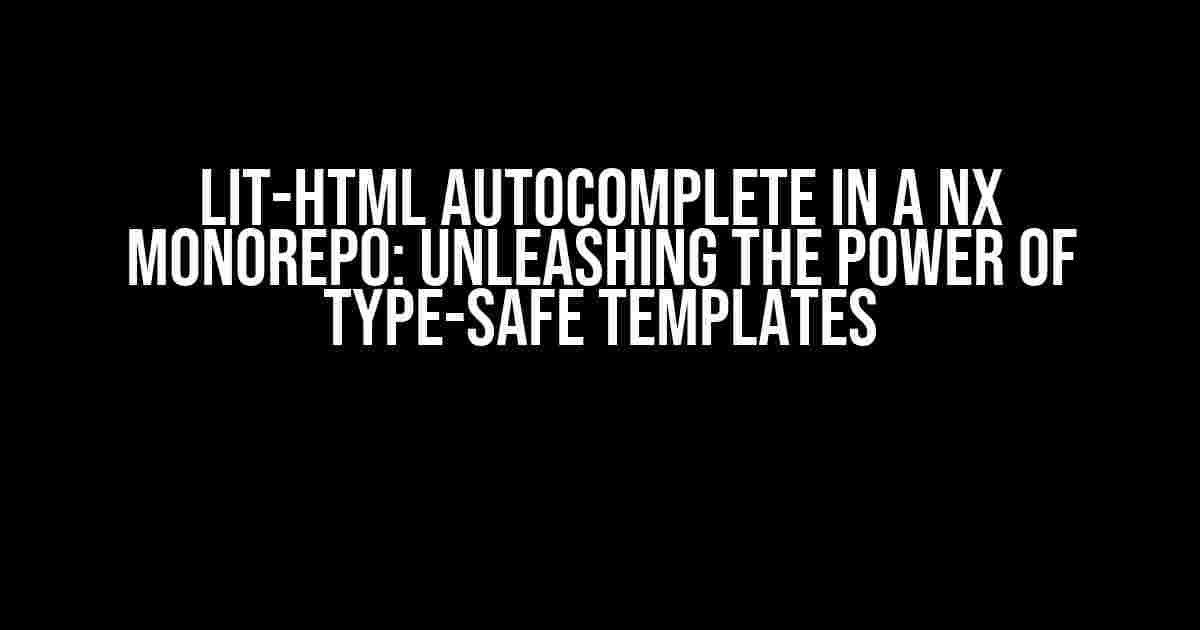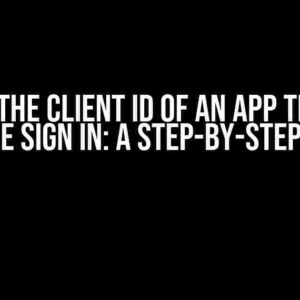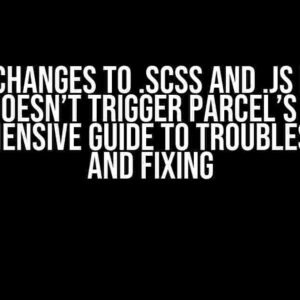Are you tired of tediously writing HTML templates with cumbersome string concatenation? Do you struggle with maintaining a consistent coding style across your NX monorepo? Look no further! In this article, we’ll explore the magic of lit-html and how to set up autocomplete for it in a NX monorepo.
What is Lit-HTML?
Lit-HTML is a lightweight, modern, and highly performant HTML templating engine developed by the Polymer Project. It provides a powerful way to render dynamic HTML content with the speed, security, and maintainability you need for complex web applications. With lit-html, you can create reusable, modular, and type-safe templates that make your coding life easier.
Why Use Lit-HTML in a NX Monorepo?
NX monorepos are a popular choice for managing large-scale, complex web applications. By integrating lit-html into your NX monorepo, you can:
- Take advantage of lit-html’s performance and security benefits
- Enforce consistent coding styles and best practices across your monorepo
- Improve code maintainability and readability with type-safe templates
- Enhance collaboration and knowledge sharing among team members
Setting Up Lit-HTML Autocomplete in a NX Monorepo
Now that we’ve covered the benefits, let’s dive into the step-by-step process of setting up lit-html autocomplete in a NX monorepo:
Step 1: Install Lit-HTML and Required Dependencies
In your NX monorepo, run the following command to install lit-html and its required dependencies:
npm install --save lit-html @types/lit-htmlStep 2: Configure Lit-HTML in Your NX Monorepo
Create a new file `lit-html.config.js` in the root of your NX monorepo with the following content:
module.exports = {
// Enable lit-html for your monorepo
enabled: true,
// Specify the directory for your lit-html templates
templateDir: 'src/templates',
// Configure thelit-html compiler
compilerOptions: {
// Enable type checking for your templates
typeCheck: true,
// Specify the target JavaScript version for your templates
target: 'es2015',
},
};Step 3: Create a Lit-HTML Template
Create a new file `hello-world.html` in the `src/templates` directory with the following content:
<template>
<h1>{{ title }}</h1>
<p>This is a lit-html template!</p>
</template>
<script>
import { html, LitElement } from 'lit-html';
@LitElement()
class HelloWorld extends LitElement {
title = 'Hello World!';
}
customElements.define('hello-world', HelloWorld);
</script>Step 4: Set Up Autocomplete for Lit-HTML in Your NX Monorepo
To enable autocomplete for lit-html in your NX monorepo, you’ll need to configure your IDE or code editor. Here’s an example for Visual Studio Code (VS Code):
Via VS Code Extensions:
Install the following extensions:
- lit-html extension by Piotr Kaczmarek
- TypeScript extension by Microsoft
Restart VS Code and open your `hello-world.html` file. You should now see autocomplete suggestions for lit-html elements and attributes.
Via VS Code Settings:
Alternatively, you can configure autocomplete for lit-html via VS Code settings:
[
{
"language": "html",
"editor.auto closingTags": true,
"editor.suggest.snippetsPreventQuickSuggestions": false,
"editor.suggest.snippets": {
"html": {
"lit-html": {
"html": {
"prefix": "lit-html",
"body": ["<template>", "${1:content}", "</template>"]
}
}
}
}
}
]Step 5: Integrate Lit-HTML Autocomplete with Your NX Monorepo
To make the most out of lit-html autocomplete in your NX monorepo, you can integrate it with your existing workflows and tools:
- Configure your NX monorepo to use lit-html templates for rendering dynamic HTML content
- Set up a code generator to automatically create lit-html templates for your components
- Integrate lit-html autocomplete with your continuous integration and continuous deployment (CI/CD) pipelines
Best Practices for Using Lit-HTML Autocomplete in a NX Monorepo
To get the most out of lit-html autocomplete in your NX monorepo, follow these best practices:
Keep Your Templates Organized
Use a consistent directory structure and naming convention for your lit-html templates to make them easily discoverable and maintainable.
Use Type-Safe Templates
Take advantage of lit-html’s type checking capabilities to ensure that your templates are type-safe and error-free.
Leverage Autocomplete for Faster Development
Use autocomplete to speed up your development workflow and reduce errors. This will help you focus on building amazing user experiences rather than tedious template syntax.
Continuously Integrate and Deploy Your Templates
Integrate your lit-html templates with your CI/CD pipelines to ensure that changes are automatically built, tested, and deployed to your production environment.
Conclusion
In this article, we’ve explored the benefits of using lit-html in a NX monorepo and provided a step-by-step guide to setting up autocomplete for lit-html templates. By following these best practices and integrating lit-html autocomplete with your existing workflows, you’ll be able to build fast, scalable, and maintainable web applications with ease.
| Benefits of Lit-HTML Autocomplete in a NX Monorepo | Advantages |
|---|---|
| Improved Development Speed | ✓ |
| Enhanced Code Maintainability | ✓ |
| Type-Safe Templates | ✓ |
| Faster Error Detection and Resolution | ✓ |
| Consistent Coding Style Across the Monorepo | ✓ |
Start unlocking the full potential of lit-html autocomplete in your NX monorepo today and take your web development to the next level!
Here are 5 Questions and Answers about “lit-html autocomplete in a NX monorepo” with a creative voice and tone:
Frequently Asked Question
Get answers to your burning questions about lit-html autocomplete in a NX monorepo!
How do I set up lit-html autocomplete in my NX monorepo?
To set up lit-html autocomplete in your NX monorepo, you’ll need to install the `@(nx) liters-plugin` and configure it in your `project.json` file. Then, make sure to enable the `lit-html` plugin in your `tsconfig.json` file. Finally, restart your IDE and you should see autocomplete working for lit-html templates!
Why is my autocomplete not working for lit-html templates in my NX monorepo?
If your autocomplete isn’t working for lit-html templates, check that you’ve installed the `@lit-ts/lit-plugin` and configured it correctly in your `project.json` file. Also, make sure you’ve enabled the `lit-html` plugin in your `tsconfig.json` file. If you’re still having issues, try deleting your `node_modules` folder and running `npm install` or `yarn install` again to reinstall your dependencies.
Can I use lit-html autocomplete in a NX monorepo with a different IDE?
Yes, you can use lit-html autocomplete in a NX monorepo with different IDEs! While the setup process might vary slightly depending on your IDE, the core configuration remains the same. For example, if you’re using Visual Studio Code, you can install the `lit-html` extension and configure it in your `settings.json` file. If you’re using IntelliJ, you can enable the `lit-html` plugin in your project settings.
How do I troubleshoot issues with lit-html autocomplete in my NX monorepo?
If you’re experiencing issues with lit-html autocomplete, try checking the console output for any error messages related to the `@lit-ts/lit-plugin`. You can also try disabling other plugins or extensions in your IDE to see if they’re interfering with the autocomplete functionality. Finally, if all else fails, try seeking help in the NX monorepo or lit-html communities!
Are there any limitations or gotchas when using lit-html autocomplete in a NX monorepo?
One limitation to keep in mind is that lit-html autocomplete might not work correctly if you’re using a mix of JavaScript and TypeScript files in your project. Additionally, if you’re using a custom `tsconfig.json` file, you might need to adjust the configuration to ensure that the `lit-html` plugin is correctly enabled. Finally, be aware that some advanced lit-html features might not be fully supported in the autocomplete functionality.





